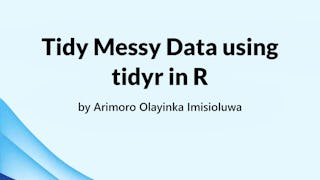Build confidence working with messy, real-world data. In this course, you’ll learn how to import, clean, and organize data in R so that it’s ready for analysis, visualization, or modeling.
Unlock access to 10,000+ courses with Coursera Plus. Start 7-Day free trial.


您将学到什么
Apply tidy data principles to manipulate and restructure data (e.g., subsetting, adding columns, and transforming data between wide and long formats)
Develop and implement code to join data sets and perform basic web scraping to collect data
Apply data structures such as wide and long formats, using code to convert between these formats as part of data preparation and analysis
您将获得的技能
要了解的详细信息

添加到您的领英档案
3 项作业
了解顶级公司的员工如何掌握热门技能

积累特定领域的专业知识
- 向行业专家学习新概念
- 获得对主题或工具的基础理解
- 通过实践项目培养工作相关技能
- 获得可共享的职业证书

该课程共有3个模块
Tidy datasets have a specific structure: each variable is a column, and each observation is a row. In this module, we use functional verbs from the dplyr package in R to transform data into a ready-to-use tidy data format. Additionally, we use functional verbs to manipulate data frames.
涵盖的内容
6个视频12篇阅读材料1个作业2个讨论话题1个插件
A column in our data set can be stored as many different types, such as numbers or characters. These different data types inform how R treats the data, and whether certain functions are compatible to use with certain types of data. In this module, we discuss more in detail, the different data types classified by R, data classes, as well as how to recode variables in a data set to be different types, classes, or take on different values.
涵盖的内容
6个视频13篇阅读材料1个作业1个讨论话题1个插件
Web scraping is the process of extracting this information automatically and transforming it into a structured dataset. In this module, we go over how to perform basic web scraping in R to make an abundance of data online more easily accessible.
涵盖的内容
4个视频6篇阅读材料1个作业2个讨论话题1个插件
获得职业证书
将此证书添加到您的 LinkedIn 个人资料、简历或履历中。在社交媒体和绩效考核中分享。
从 Data Analysis 浏览更多内容
 状态:免费试用
状态:免费试用Johns Hopkins University
 状态:免费试用
状态:免费试用Microsoft

Coursera
 状态:免费试用
状态:免费试用Johns Hopkins University
人们为什么选择 Coursera 来帮助自己实现职业发展




常见问题
To access the course materials, assignments and to earn a Certificate, you will need to purchase the Certificate experience when you enroll in a course. You can try a Free Trial instead, or apply for Financial Aid. The course may offer 'Full Course, No Certificate' instead. This option lets you see all course materials, submit required assessments, and get a final grade. This also means that you will not be able to purchase a Certificate experience.
When you enroll in the course, you get access to all of the courses in the Specialization, and you earn a certificate when you complete the work. Your electronic Certificate will be added to your Accomplishments page - from there, you can print your Certificate or add it to your LinkedIn profile.
Yes. In select learning programs, you can apply for financial aid or a scholarship if you can’t afford the enrollment fee. If fin aid or scholarship is available for your learning program selection, you’ll find a link to apply on the description page.
更多问题
提供助学金,





